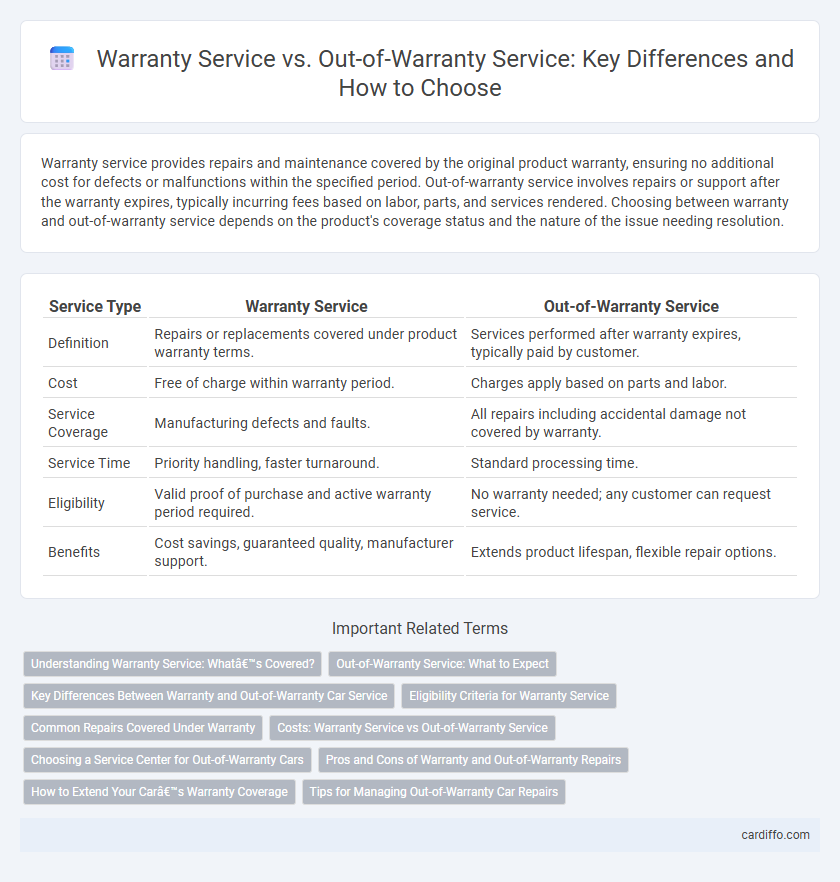Warranty service provides repairs and maintenance covered by the original product warranty, ensuring no additional cost for defects or malfunctions within the specified period. Out-of-warranty service involves repairs or support after the warranty expires, typically incurring fees based on labor, parts, and services rendered. Choosing between warranty and out-of-warranty service depends on the product's coverage status and the nature of the issue needing resolution.
Table of Comparison
| Service Type | Warranty Service | Out-of-Warranty Service |
|---|---|---|
| Definition | Repairs or replacements covered under product warranty terms. | Services performed after warranty expires, typically paid by customer. |
| Cost | Free of charge within warranty period. | Charges apply based on parts and labor. |
| Service Coverage | Manufacturing defects and faults. | All repairs including accidental damage not covered by warranty. |
| Service Time | Priority handling, faster turnaround. | Standard processing time. |
| Eligibility | Valid proof of purchase and active warranty period required. | No warranty needed; any customer can request service. |
| Benefits | Cost savings, guaranteed quality, manufacturer support. | Extends product lifespan, flexible repair options. |
Understanding Warranty Service: What’s Covered?
Warranty service covers repairs and replacements for defects in materials or workmanship within a specified period, typically ranging from one to several years depending on the product. This service ensures that manufacturers address issues without additional cost, including parts and labor for covered components. Understanding the exact terms and limitations of warranty coverage helps consumers know when service requests qualify and avoid unexpected expenses.
Out-of-Warranty Service: What to Expect
Out-of-warranty service typically involves repair or maintenance costs that are not covered by the manufacturer, requiring customers to pay for parts and labor. Response times and service priorities may differ from warranty-covered repairs, with possible extended turnaround periods. Customers can expect detailed diagnostics, transparent pricing estimates, and optional upgrades or replacements during the out-of-warranty service process.
Key Differences Between Warranty and Out-of-Warranty Car Service
Warranty service provides repairs and maintenance covered under the vehicle's manufacturer warranty, typically at no additional cost to the owner, ensuring compliance with warranty terms and preserving resale value. Out-of-warranty service requires the owner to bear the full cost of repairs or maintenance once the warranty period expires or certain coverage conditions are not met, often resulting in higher expenses. Key differences include cost responsibility, coverage scope, and eligibility criteria, with warranty service emphasizing preventive or defect-related repairs and out-of-warranty service covering all subsequent repair needs.
Eligibility Criteria for Warranty Service
Warranty service eligibility requires the product to be within the manufacturer's specified warranty period, typically ranging from one to five years from the purchase date. Proof of purchase, such as a receipt or invoice, is essential to confirm the product's warranty status and validate the claim. Damage or defects must be due to manufacturing faults, excluding user mishandling or accidental damage, to qualify for warranty coverage.
Common Repairs Covered Under Warranty
Warranty service typically covers common repairs such as manufacturing defects, faulty parts replacement, and system malfunctions within the warranty period. Out-of-warranty service often involves repairs for wear and tear, accidental damage, or issues arising after the warranty has expired. Understanding the distinction helps customers identify eligible repairs covered under warranty and anticipate potential costs for out-of-warranty services.
Costs: Warranty Service vs Out-of-Warranty Service
Warranty service typically covers repair or replacement costs at no charge, ensuring minimal or zero expenses for the customer within the warranty period. Out-of-warranty service incurs full repair fees, often including parts and labor, leading to significantly higher costs compared to warranty coverage. Understanding the cost differences helps consumers make informed decisions about maintaining or extending warranty protections.
Choosing a Service Center for Out-of-Warranty Cars
Choosing a service center for out-of-warranty cars requires evaluating expertise in diverse repair needs and availability of genuine parts. Service centers specializing in out-of-warranty repairs often offer flexible payment options and customized maintenance plans tailored to aging vehicles. Prioritizing certified technicians and customer reviews ensures reliable diagnostics and long-term performance restoration.
Pros and Cons of Warranty and Out-of-Warranty Repairs
Warranty service offers cost-effective repairs covered by the manufacturer, providing peace of mind and ensuring that quality standards are maintained; however, it is limited to a specific period and may exclude certain types of damages or parts. Out-of-warranty service provides flexibility to repair any issues beyond the warranty period or those not covered, though it often involves higher costs and risks of variable repair quality. Choosing between warranty and out-of-warranty repairs depends on factors such as repair urgency, cost sensitivity, and trust in service providers.
How to Extend Your Car’s Warranty Coverage
Extending your car's warranty coverage involves purchasing an extended warranty or service contract before the original manufacturer's warranty expires, offering protection against costly repairs after the standard warranty period. Many providers offer plans tailored to your vehicle's make, model, and mileage, which can be customized to include powertrain, bumper-to-bumper, or additional component coverage. Regular maintenance and keeping detailed service records are essential to qualify for extended warranty programs and maximize the coverage benefits.
Tips for Managing Out-of-Warranty Car Repairs
Out-of-warranty car repairs often involve higher costs and limited coverage, making it essential to prioritize diagnostic accuracy and obtain detailed repair estimates before authorizing work. Engaging certified technicians and using genuine parts can extend vehicle longevity and reduce recurring issues. Establishing a maintenance schedule and exploring extended warranty options also help manage expenses and protect against unexpected breakdowns.
Warranty Service vs Out-of-Warranty Service Infographic

 cardiffo.com
cardiffo.com